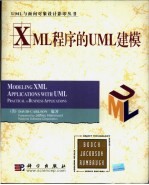图书介绍
XML程序的UML建模PDF|Epub|txt|kindle电子书版本网盘下载

- (美)卡尔森(Carlson,D.)编著 著
- 出版社: 北京:科学出版社
- ISBN:703012491X
- 出版时间:2004
- 标注页数:333页
- 文件大小:21MB
- 文件页数:354页
- 主题词:可扩充语言,XML-程序设计-英文;面向对象语言,UML-程序设计-英文
PDF下载
下载说明
XML程序的UML建模PDF格式电子书版下载
下载的文件为RAR压缩包。需要使用解压软件进行解压得到PDF格式图书。建议使用BT下载工具Free Download Manager进行下载,简称FDM(免费,没有广告,支持多平台)。本站资源全部打包为BT种子。所以需要使用专业的BT下载软件进行下载。如BitComet qBittorrent uTorrent等BT下载工具。迅雷目前由于本站不是热门资源。不推荐使用!后期资源热门了。安装了迅雷也可以迅雷进行下载!
(文件页数 要大于 标注页数,上中下等多册电子书除外)
注意:本站所有压缩包均有解压码: 点击下载压缩包解压工具
图书目录
PART Ⅰ FOUNDATIONS1
Chapter 1 Convergence of Communities3
Models for e-Business4
Stakeholder Communities5
Consumer6
Business Analyst8
Web Application Specialist9
System Integration Specialist10
Content Developer10
Part Ⅰ. Foundations11
Part Ⅱ. XML Vocabularies11
ContentsForeword11
Road Map for This Book11
Part Ⅲ. Deployment12
Steps for Success13
Preface15
Chapter 2 What Is an XML Application?15
HTML, XML, and XHTML15
XML Vocabularies18
XML Presentation23
Cascading Style Sheets23
XSLT Stylesheets26
Chapter Summary29
Steps for Success30
Chapter 3 What Is a UML Model?31
Models and Views32
Requirements Workflow33
Use Case Diagram33
Analysis Workflow35
Activity Diagram35
Model Management Diagram37
Collaboration Diagram37
Design Workflow39
Class Diagram40
Object Diagram43
Sequence Diagram45
Component Diagram46
The Unified Process47
Chapter Summary49
Steps for Success50
Chapter 4 e-Business Integration with XML51
Use Case Analysis52
Catalog Vocabulary Requirements54
Shared Business Vocabularies55
Define Business Vocabulary55
Create XML Schema56
Validate Message59
Transform Message Content60
Process Workflow and Messaging61
Define Business Process61
Build Workflow Model62
Define Message Protocol64
Application Integration65
Create Application Classes65
Create Legacy Adapter67
Chapter Summary68
Steps for Success69
Chapter 5 Building Portals with XML71
Use Case Analysis72
Content Management74
Define Business Vocabulary74
Create Content74
Assign Content Metadata77
Portal Design77
Design Portlet78
Design Content Template80
Create Stylesheet81
Design Portal Layout83
Customize Portal Layout83
Wired and Wireless Convergence84
Chapter Summary86
Steps for Success87
PART Ⅱ XML VOCABULARIES89
Chapter 6 Modeling XML Vocabularies91
What Is a Vocabulary?91
CatML Vocabulary93
Simplified Product Catalog Model94
Mapping UML to XML95
XML Metadata Interchange97
Disassembling UML Objects into XML99
UML Classes to XML Elements99
Inheritance101
UML Attributes to XML Elements102
UML Attributes to XML Attributes103
Enumerated Attribute Values106
Mapping UML Compositions107
Mapping UML Associations109
Roots and Broken Branches111
Packaging Vocabularies113
FpML Vocabulary114
UML Packages115
XML Namespaces117
Chapter Summary119
Steps for Success120
Chapter 7 From Relationships to Hyperlinks121
Expanded CatML Vocabulary122
XML Standards for Linking125
XML ID and IDREF126
XPath128
XPointer132
XLink134
A Hyperlinked CatML Vocabulary136
Negotiated Price Lists137
Product Bundles140
Product Details142
Taxonomy of Categories144
Chapter Summary153
Steps for Success154
Chapter 8 XMLDTDs and Schemas155
The Role of an XML Schema156
XML Document Type Definition159
DTD Element Declarations and Content Model159
DTD Attribute Declarations162
DTD Entity Declarations164
Limitations of DTDs165
W3C XML Schema166
Datatypes and Datatype Refinement167
Schemas Compatible with DTDs170
Advanced Schema Structures175
Replacement or Coexistence?179
Chapter Summary179
Steps for Success181
Chapter 9 Generating XML Schemas from the UML183
Principles of Schema Generation184
Generating DTDs185
Relaxed DTDs186
Strict DTDs191
Generating W3C XML Schemas194
Relaxed Schemas194
Strict Schemas201
XLink Support203
Controlling Schema Strictness205
UML Extension Profiles205
An Extension Profile for XML208
Profile Applied to CatML209
Chapter Summary214
Steps for Success215
PART Ⅲ DEPLOYMENT217
Chapter 10 Vocabulary Transformation219
Reasons for XML Transformation219
Alternative Vocabularies220
Filtering Sensitive or Irrelevant Data220
Introduction to XSLT221
Presenting XML Documents221
Exporting Non-XML Data221
XSLT Processing Model222
Transformation Rules224
Integrating CatML with RosettaNet226
Importing a RosettaNet Dictionary227
Exporting a RosettaNet Sales Catalog233
Chapter Summary241
Steps for Success242
Bibliography242
Chapter 11 B2B Portal Presentation243
Portal Analysis Model244
Transforming XML Documents into Portlets246
A Portlet for Product Display249
A Portlet for Promotional Discounts254
Discount Transformation256
RSS Transformation263
Chapter Summary265
Steps for Success265
Chapter 12 e-Business Architecture267
Requirements for e-Business Architecture268
Deploying Web Services269
Message Protocols in XML269
Web Service Description272
Web Service Discovery273
CatX Component Architecture274
Display Portal Content277
Update Newsfeed277
Query Catalog Content278
Integrate Supplier Catalog279
Execute Currency Trade279
Query Schema Repository280
Query Service Registry280
Chapter Summary281
Steps for Success283
PART Ⅳ APPENDIXES285
Appendix A Reuse of FpML Vocabulary287
Trading Party Model291
Appendix B MOF and XMI295
Meta Object Facility295
XML Metadata Interchange298
Appendix C UML Profile for XML301
Introduction301
Stereotypes302
Bibliography Example310
References315
Index317